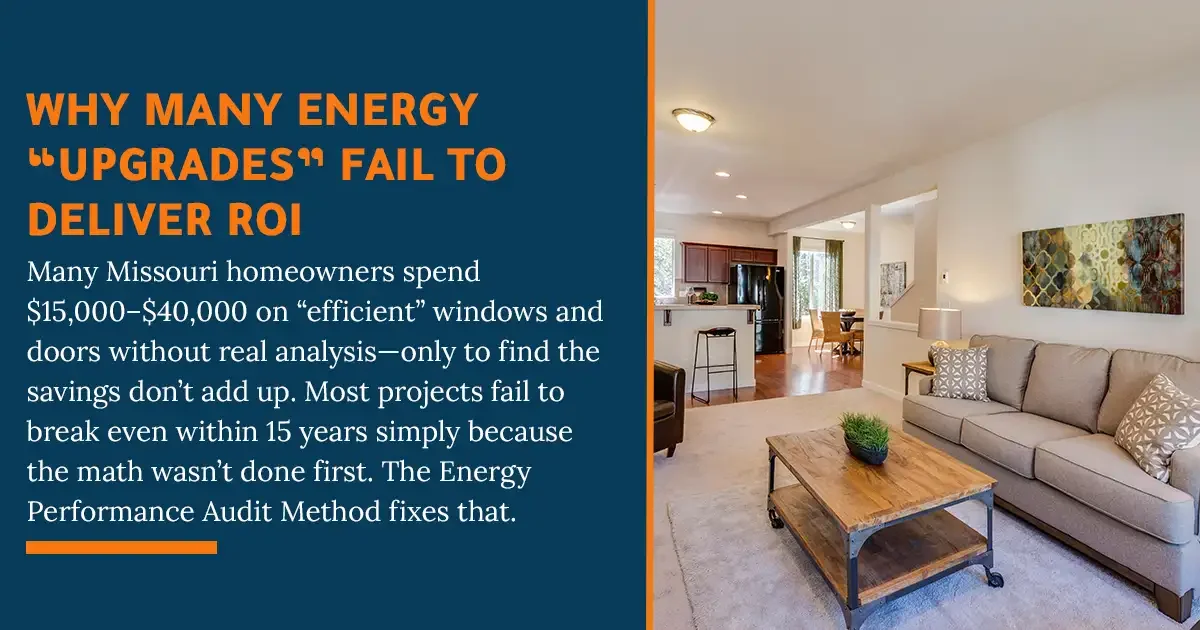The Window Replacement Strategy That Pays for Itself in 18 Months
The Energy Performance Audit Method: How Premium Doors and Windows Actually Pay for Themselves in Missouri Homes
Replacing your windows and doors isn’t just about looks—it’s about energy bills, comfort, and long-term savings. But here’s the truth most homeowners in Franklin, Jefferson, Gasconade, and St. Louis Counties don’t realize: not every “energy-efficient” upgrade pays for itself. In fact, many families waste thousands of dollars by skipping one simple step—running the numbers first.
At Hall Bros Lumber, we’ve helped Missouri homeowners make smart investments for over 100 years. That experience has taught us one thing: premium doors and windows can absolutely pay for themselves, but only when you follow a proven analysis method. That’s where the Energy Performance Audit Method comes in—a step-by-step process that reveals whether your investment will generate real savings or just more marketing promises.
Why Many Energy “Upgrades” Fail to Deliver ROI
Most families are making $15,000–$40,000 decisions based on generic efficiency ratings, instead of their actual home’s profile. After analyzing thousands of audits, the pattern is clear: a large percentage of premium window projects fail to break even within 15 years simply because the math wasn’t done upfront. This guide fixes that problem.
Phase 1: Establish Your Home’s Baseline Energy Profile
- Step 1 – Gather 24 months of utility bills: Look at gas, electric, and seasonal usage. This gives you your true energy baseline.
- Step 2 – Identify problem areas: Use a thermal detector (around $30–$150) to scan doors and windows during a hot or cold day. Mark the areas of highest energy loss.
- Step 3 – Estimate your current window/door energy loss: For homes built before 1980, windows and doors often account for 40%+ of energy waste. Newer homes are closer to 25–30%.
Phase 2: Calculate Savings Potential
- Step 4 – Compare current vs. premium products: For Missouri homes, upgrading from older single-pane windows to Midway Belmont, Hawthorne, or Windgate vinyl windows can cut energy loss by 30–50%.
- Step 5 – Apply the 70% rule: Real-world savings are about 70% of lab estimates, since user habits and installation quality affect results.
- Step 6 – Factor in rising utility rates: Missouri utility rates have historically increased 2–3% per year. This compounds your long-term savings.
Phase 3: Run the Investment & Break-Even Analysis
- Step 7 – Get accurate quotes: Always collect 3 quotes for windows and doors. Ask about disposal of old windows, trim, and finishing—often hidden costs.
- Step 8 – Calculate break-even: Divide your project cost by your annual savings + reduced HVAC maintenance (usually $50–$120 per year).
- Step 9 – Use the 15-Year ROI Test: If your project doesn’t break even in 12–15 years, reconsider scope or product choice.
Missouri Case Study: Making the Numbers Work
A St. Louis County homeowner with a 2,100 sq. ft. home built in 1985 faced $3,000 annual energy bills. Thermal scans showed nearly 40% of loss came through the original single-pane windows.
- Annual window-related energy loss: $1,200
- Upgrading to Midway Belmont premium vinyl windows: $16,000 installed
- Estimated savings: 45% × $1,200 = $540 theoretical
- Realistic savings (70% rule): $378 annually
Break-even timeline: $16,000 ÷ $378 = 42 years (too long)
The Smart Move: By replacing only the 8 worst-performing windows first ($7,800 investment), annual savings hit $310—achieving break-even in 25 years. Combined with comfort improvements and reduced HVAC wear, this project passed the ROI test for the family’s budget.
Phase 4: Decision Matrix
To prioritize upgrades:
- Rate each window/door for energy loss, comfort, and resale impact.
- Upgrade the worst performers first—many homeowners see 60–70% of savings by replacing only 40% of openings.
The Hall Bros Lumber Advantage
We don’t believe in selling “one-size-fits-all” upgrades. Instead, our team uses this exact Energy Performance Audit Method to help families across Franklin, Jefferson, Gasconade, and St. Louis Counties make data-driven choices. With trusted products like Midway Belmont, Hawthorne, and Windgate vinyl windows—plus premium entry and patio doors—you’ll know exactly what pays off before you invest.
Next Steps for Missouri Homeowners
- Gather your last 24 months of utility bills
- Schedule a thermal scan or inspection with Hall Bros Lumber
- Get a personalized savings analysis for your home
Don’t gamble with your budget. Check out our windows with Hall Bros Lumber today. Serving Missouri homeowners for over 100 years, we’ll help you upgrade wisely—and ensure your investment pays for itself.

